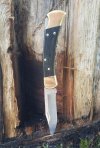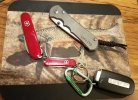You know, I was about to say "nice try but I'm sold Leatherman" but after looking at the larger SAK, I found the almost perfect complement to my leatherman project.
My most used tool right now is the blade and the scissor, leatherman making "badly" the later. I though victorinox didn't make big scissor but I was wrong.
I will go with the rangergrip 71 gardener. I didn't plan on a multitool, but it's just too spot on my need to pass.
I just have no idea how the "Inox" stainless from victorinox compare to the 420 stainless from leatherman. As long as it's not worst, it will be fine for me.
It's softer or something. Which doesn't make it worse. Just makes it different. And I can't get it to rust. So I can wash my knife shake it off and throw it in my pocket.
But yeah SAKs are good whittling knives in my opinion.


